AK-47. Kalashnikov: The Amateur Inventor Who Shot to Global Fame
Review of Biographical Film about Mikhail Timofeyevich Kalashnikov (1919–2013)

All Global Research articles can be read in 51 languages by activating the “Translate Website” drop down menu on the top banner of our home page (Desktop version).
***
AK-47: Kalashnikov (2020) is a biographical film about Mikhail Timofeyevich Kalashnikov (1919–2013), the inventor and designer of the AK-47 automatic rifle. This Russian film, released in February of last year, follows the young Kalashnikov as he is bombarded by Germans during WWII and interspersed with flashbacks of his childhood. Disturbed by the failure of a newly designed gun that nearly gets a comrade killed when it jams, he examines the parts and lists out various problems with the new design. An amatuer inventor who had been playing around various types of primitive gun designs since he was child, Kalashnikov goes back to work in a steam engine workshop after being injured in battle. There he is assigned a desk and tools, and struggles to assemble a new design he had been drawing up. Help is at hand when the other workers in the workshop offer their after-hours services to help him tool the parts necessary for his new design. After this, his life takes many twists and turns as he struggles to perfect his design and gain acceptance through inventor competitions, testing ranges and the military hierarchy.
The story focuses on his drive and sincerity in producing a safer gun that would help the Soviets win the war. Although the gun he is famous for was not produced until 1947 (“Avtomát Kaláshnikova” (Russian: Автома́т Кала́шникова, lit. ‘Kalashnikov’s Automatic Gun’), its reliability and design ensured its wide use in many armies around the world in subsequent decades. The film also strives to show Kalashnikov as a role model for how someone with a basic education (Kalashnikov left school after seventh grade) can achieve so much in the way of plaudits and global fame.
Image on the right: Kalashnikov’s first submachine gun
In AK-47: Kalashnikov, the testing processes of the gun were not complete successes but Kalashnikov is given more promotions and more help in developing his ideas. With the development of new technologies, a simplified, lighter version of the automatic rifle was developed which soon became the most ubiquitous variant of the AK-47. In the real world, the popularity of the design meant that “approximately 100 million AK-47 assault rifles had been produced by 2009, and about half of them are counterfeit, manufactured at a rate of about a million per year. Izhmash, the official manufacturer of AK-47 in Russia, did not patent the weapon until 1997, and in 2006 accounted for only 10% of the world’s production.”
The film is beautifully shot with realistic battle scenes and panoramic landscape settings. The relations between the soldiers, and between the soldiers and their superiors are developed without the stereotyped or charicatured portrayals seen in films like Enemy at the Gates (2001), as Kalashnikov gets help and encouragement all around him, even at his lowest points when he feels like giving up. Moreover, in these days of instant-everything and easy consumption access to any product, it is refreshing to see male and female workers with so many skills (including his drafting technician who becomes his wife) bringing an idea from drawings through precision tooling to the finished gleaming weapon.
Kalashnikov himself did suffer “spiritual pain” about whether he was responsible for the deaths caused by his weapons, but also believed that their use was defensive rather than offensive. The AK-47 has been used in many anti-colonial wars and received the ultimate praise when appearing on some national flags and coats of arms. Of course like any weapon his guns have been used in terrorist organisations but one could argue that overall its reliability and simplicity evened up the stakes in many an asymmetrical war.
Watch the trailer below.
Kalashnikov was hospitalized on 17 November 2013, in Izhevsk, the capital of Udmurtia and where he lived and died on 23 December 2013, at age 94 from gastric hemorrhage. A statue dedicated to Kalashnikov was commissioned by the Russian Military Historical Society and unveiled in Moscow in 2017. It is a 7.5m (25ft) monument, which shows Kalashnikov holding an AK-47 in his arms. However, it was soon spotted that the technical drawing of the gun etched onto a metallic plate at the base of the monument was actually of an StG 44 rifle used by the Nazis during WWII.
The symbolism of this mistake was not lost on the public, a country that lost millions of its people at the hands of the Nazi invasion which started on Sunday, 22 June 1941. The section of the metallic plate with the gun design was soon removed with an angle grinder.
*
Note to readers: please click the share buttons above or below. Forward this article to your email lists. Crosspost on your blog site, internet forums. etc.
Caoimhghin Ó Croidheáin is an Irish artist, lecturer and writer. His artwork consists of paintings based on contemporary geopolitical themes as well as Irish history and cityscapes of Dublin. His blog of critical writing based on cinema, art and politics along with research on a database of Realist and Social Realist art from around the world can be viewed country by country here. He is a Research Associate of the Centre for Research on Globalization.
Featured image: Mikhail Timofeyevich Kalashnikov (1919–2013) Kalashnikov at the Kremlin, December 2009


